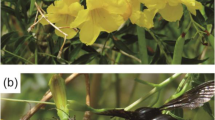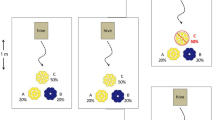Abstract
How do nectar-feeding animals choose among alternative flower-handling tactics? Such decisions have consequences not only for animal fitness (via food intake) but for plant fitness as well: many animals can choose to “rob” nectar through holes chewed in the base of a flower instead of “legitimately” collecting it through the flower’s opening, thus failing to contact pollen. Although variation within a species in these nectar-foraging tactics is well documented, it is largely unknown why some individuals specialize (at least in the short term) on robbing, others on legitimate visitation, and others switch between these behaviors. We investigated whether the tendency to rob nectar through previously-made holes (secondary robbing) is influenced by prior foraging experience. In a laboratory experiment, we trained groups of bumble bees (Bombus impatiens) either to visit artificial flowers legitimately or to secondary-rob; a third group received no training. On subsequent visits to flowers, all bees had the opportunity to use either foraging tactic. We found that experience did affect bees’ tendency to secondary-rob: trained bees were more likely to adopt the tactic they had previously experienced. Untrained bees initially sampled both tactics, but over time preferred to secondary-rob. Experience also increased bees’ success at gaining nectar from flowers, but only when visiting flowers legitimately (the less preferred tactic). Overall, these findings highlight the importance of experience in animals’ choices of alternative handling tactics while foraging and help explain long-standing observations of variation in nectar-robbing behavior among individuals of the same population.
Significance statement
Animals that can adopt alternative behaviors frequently use only one of them. A widespread but little understood example of this is nectar feeding, in which foragers can choose between “legitimately” collecting nectar through a flower’s opening or “robbing” nectar via holes chewed through a flower’s base. We showed in a laboratory experiment that prior foraging experience can bias bumble bees’ choices to rob nectar from pre-existing holes (i.e., to “secondary”-rob). Initial exposure to flowers that could only be robbed or only be legitimately visited increased bees’ tendency to subsequently adopt that behavior at the expense of sampling the alternative behavior, even when other bees seemed to prefer the alternative. These results help explain field observations that bees often specialize on a single nectar-collecting behavior and that there is individual variation in which behavior is adopted, contributing to our understanding of nectar robbing from the animals’ perspective.





Similar content being viewed by others
References
Aplin LM, Sheldon BC, Morand-Ferron J (2013) Milk bottles revisited: social learning and individual variation in the blue tit, Cyanistes caeruleus. Anim Behav 85:1225–1232. https://doi.org/10.1016/j.anbehav.2013.03.009
Bronstein JL, Barker JL, Lichtenberg EM, Richardson LL, Irwin RE (2017) The behavioral ecology of nectar robbing: why be tactic constant? Curr Opin Insect Sci 21:14–18. https://doi.org/10.1016/j.cois.2017.05.013
Chittka L, Muller H (2009) Learning, specialization, efficiency and task allocation in social insects. Commun Integr Biol 2:151–154. https://doi.org/10.4161/cib.7600
Chittka L, Raine NE (2006) Recognition of flowers by pollinators. Curr Opin Plant Biol 9:428–435. https://doi.org/10.1016/j.pbi.2006.05.002
Chittka L, Thomson JD (1997) Sensori-motor learning and its relevance for task specialization in bumble bees. Behav Ecol Sociobiol 41:385–398. https://doi.org/10.1007/s002650050400
Chittka L, Thomson JD (eds) (2005) Cognitive ecology of pollination: animal behaviour and floral evolution. Cambridge University Press, Cambridge
Chittka L, Gumbert A, Kunze J (1997) Foraging dynamics of bumble bees: correlates of movements within and between plant species. Behav Ecol 8:239–249. https://doi.org/10.1093/beheco/8.3.239
Chittka L, Thomson JD, Waser NM (1999) Flower constancy, insect psychology, and plant evolution. Naturwissenschaften 86:361–377. https://doi.org/10.1007/s001140050636
Costa TM, Hebets EA, Melo D, Willemart RH (2016) Costly learning: preference for familiar food persists despite negative impact on survival. Biol Lett 12:20160256. https://doi.org/10.1098/rsbl.2016.0256
Custance D, Whiten A, Fredman T (1999) Social learning of an artificial fruit task in capuchin monkeys (Cebus apella). J Comp Psychol 113:13–23. https://doi.org/10.1037/0735-7036.113.1.13
Dedej S, Delaplane KS (2004) Nectar-robbing carpenter bees reduce seed-setting capability of honey bees (Hymenoptera: Apidae) in rabbiteye blueberry, Vaccinium ashei, “climax.”. Environ Entomol 33:100–106. https://doi.org/10.1603/0046-225X-33.1.100
Dedej S, Delaplane KS (2005) Net energetic advantage drives honey bees (Apis mellifera L) to nectar larceny in Vaccinium ashei Reade. Behav Ecol Sociobiol 57:398–403. https://doi.org/10.1007/s00265-004-0852-z
Dukas R (1995) Transfer and interference in bumblebee learning. Anim Behav 49:1481–1490. https://doi.org/10.1016/0003-3472(95)90069-1
Free JB (1968) The behaviour of bees visiting runner beans (Phaseolus multiflorus). J Appl Ecol 5:631–638. https://doi.org/10.2307/2401637
Gegear RJ, Thomson JD (2004) Does the flower constancy of bumble bees reflect foraging economics? Ethology 110:793–805. https://doi.org/10.1111/j.1439-0310.2004.01010.x
Goulson D (1999) Foraging strategies of insects for gathering nectar and pollen, and implications for plant ecology and evolution. Perspect Plant Ecol Evol Syst 2:185–209. https://doi.org/10.1078/1433-8319-00070
Goulson D, Park KJ, Tinsley MC, Bussière LF, Vallejo-Marin M (2013) Social learning drives handedness in nectar-robbing bumblebees. Behav Ecol Sociobiol 67:1141–1150. https://doi.org/10.1007/s00265-013-1539-0
Grant V (1950) The flower constancy of bees. Bot Rev 16:379–398. https://doi.org/10.1007/BF02869992
Heinrich B (1976) The foraging specializations of individual bumblebees. Ecol Monogr 46:105–128. https://doi.org/10.2307/1942246
Heinrich B (1979) “Majoring” and “minoring” by foraging bumblebees, Bombus vagans: an experimental analysis. Ecology 60:245–255. https://doi.org/10.2307/1937652
Heinrich B, Raven PH (1972) Energetics and pollination ecology. Science 176:597–602. https://doi.org/10.1126/science.176.4035.597
Hervé M (2017) RVAideMemoire: diverse basic statistical and graphical functions. R package version 0.9–65. https://CRAN.R-project.org/package=RVAideMemoire
Inouye DW (1980) The terminology of floral larceny. Ecology 61:1251–1253. https://doi.org/10.2307/1936841
Irwin RE, Maloof JE (2002) Variation in nectar robbing over time, space, and species. Oecologia 133:525–533. https://doi.org/10.1007/s00442-002-1060-z
Irwin RE, Brody AK, Waser NM (2001) The impact of floral larceny on individuals, populations, and communities. Oecologia 129:161–168. https://doi.org/10.1007/s004420100739
Irwin RE, Bronstein JL, Manson JS, Richardson L (2010) Nectar robbing: ecological and evolutionary perspectives. Annu Rev Ecol Evol Syst 41:271–292. https://doi.org/10.1146/annurev.ecolsys.110308.120330
Ishii HS, Kadoya EZ (2016) Legitimate visitors and nectar robbers on Trifolium pratense showed contrasting flower fidelity versus co-flowering plant species: could motor learning be a major determinant of flower constancy by bumble bees? Behav Ecol Sociobiol 70:377–386. https://doi.org/10.1007/s00265-016-2057-7
Pinheiro J, Bates D, DebRoy S, Sarkar D, R Core Team (2017) nlme: linear and nonlinear mixed effects models. r package version 3.1–131. https://CRAN.R-project.org/package=nlme
Keasar T, Motro U, Shur Y, Shmida A (1996) Overnight memory retention of foraging skills by bumblebees is imperfect. Anim Behav 52:95–104. https://doi.org/10.1006/anbe.1996.0155
Keasar T, Motro U, Shmida A (2013) Temporal reward variability promotes sampling of a new flower type by bumblebees. Anim Behav 86:747–753. https://doi.org/10.1016/j.anbehav.2013.07.010
Kells AR, Goulson D (2001) Evidence for handedness in bumblebees. J Insect Behav 14:47–55. https://doi.org/10.1023/A:1007897512570
Laverty TM (1980) The flower-visiting behaviour of bumble bees: floral complexity and learning. Can J Zool 58:1324–1335. https://doi.org/10.1139/z80-184
Laverty TM (1994a) Costs to foraging bumble bees of switching plant species. Can J Zool 72:43–47. https://doi.org/10.1139/z94-007
Laverty TM (1994b) Bumble bee learning and flower morphology. Anim Behav 47:531–545. https://doi.org/10.1006/anbe.1994.1077
Leadbeater E, Chittka L (2008) Social transmission of nectar-robbing behaviour in bumble-bees. Proc R Soc B 275:1669–1674. https://doi.org/10.1098/rspb.2008.0270
Lenth RV (2016) Least-squares means: the R package lsmeans. J Stat Softw 69:1–33. https://doi.org/10.18637/jss.v069.i01
Leonard AS, Brent J, Papaj DR, Dornhaus A (2013) Floral nectar guide patterns discourage nectar robbing by bumble bees. PLoS One 8:e55914. https://doi.org/10.1371/journal.pone.0055914
Lewis AC (1986) Memory constraints and flower choice in Pieris rapae. Science 232:863–865. https://doi.org/10.1126/science.232.4752.863
Maloof JE, Inouye DW (2000) Are nectar robbers cheaters or mutualists? Ecology 81:2651–2661. https://doi.org/10.2307/177331
Mondal S, Hutchings JA, Herbert GS (2014) A note on edge drilling predation by naticid gastropods. J Molluscan Stud 80:206–212. https://doi.org/10.1093/mollus/eyu001
Muth F, Keasar T, Dornhaus A (2015) Trading off short-term costs for long-term gains: how do bumblebees decide to learn morphologically complex flowers? Anim Behav 101:191–199. https://doi.org/10.1016/j.anbehav.2014.12.024
Newman DA, Thomson JD (2005) Effects of nectar robbing on nectar dynamics and bumblebee foraging strategies in Linaria vulgaris (Scrophulariaceae). Oikos 110:309–320. https://doi.org/10.1111/j.0030-1299.2005.13884.x
Pelletier L, McNeil JN (2003) The effect of food supplementation on reproductive success in bumblebee field colonies. Oikos 103:688–694. https://doi.org/10.1034/j.1600-0706.2003.12592.x
Pyke GH (1980) Optimal foraging in bumblebees: calculation of net rate of energy intake and optimal patch choice. Theor Popul Biol 17:232–246. https://doi.org/10.1016/0040-5809(80)90008-8
R Core Team (2017) R: a language and environment for statistical computing. R foundation for statistical computing, Vienna, Austria. https://www.R-project.org/
Ravary F, Lecoutey E, Kaminski G, Châline N, Jaisson P (2007) Individual experience alone can generate lasting division of labor in ants. Curr Biol 17:1308–1312. https://doi.org/10.1016/j.cub.2007.06.047
Richardson SC (2004) Are nectar-robbers mutualists or antagonists? Oecologia 139:246–254. https://doi.org/10.1007/s00442-004-1504-8
Richardson LL, Bronstein JL (2012) Reproductive biology of pointleaf manzanita (Arctostaphylos pungens) and the pollinator-nectar robber spectrum. J Pollinat Ecol 9:115–123
Richman SK, Irwin RE, Bronstein JL (2017a) Foraging strategy predicts foraging economy in a facultative secondary nectar robber. Oikos 126:158–169. https://doi.org/10.1111/oik.04229
Richman SK, Irwin RE, Nelson CJ, Bronstein JL (2017b) Facilitated exploitation of pollination mutualisms: fitness consequences for plants. J Ecol 105:188–196. https://doi.org/10.1111/1365-2745.12657
Rust RW (1979) Pollination of Impatiens capensis: pollinators and nectar robbers. J Kansas Entomol Soc 52:297–308
Schmid-Hempel R, Schmid-Hempel P (1998) Colony performance and immunocompetence of a social insect, Bombus terrestris, in poor and variable environments. Funct Ecol 12:22–30. https://doi.org/10.1046/j.1365-2435.1998.00153.x
Stephens DW, Krebs JR (1987) Foraging theory. Princeton University Press, Princeton
Stephens DW, Brown JS, Ydenberg RC (2007) Foraging: behavior and ecology. University of Chicago Press, Chicago
Waser NM (1986) Flower constancy: definition, cause and measurement. Am Nat 127:593–603. https://doi.org/10.1086/284507
Wickham H, Francois R, Henry L, Müller K (2017) dplyr: a grammar of data manipulation. R package version 0.7.0. https://CRAN.R-project.org/package=dplyr
Woodward GL, Laverty TM (1992) Recall of flower handling skills by bumble bees: a test of Darwin’s interference hypothesis. Anim Behav 44:1045–1051. https://doi.org/10.1016/S0003-3472(05)80316-1
Acknowledgements
We thank Caitlin Stern for insightful discussion and Dan Papaj and lab members for loan of equipment and further helpful discussion. Kit Henker, Autri Hafezi, Kellen Fortier, Gianna Trujillo, Nico Rizzo, Daniel Thews, Ellen Young, Sage Cutler, and Michael Rivera assisted with conducting experiments; Heather Ellison, Leyton Galapia, Laker Dohan and Nico Rizzo assisted with scoring videos.
Funding
This work was funded by National Institutes of Health grant 5K12GM000708-13; National Science Foundation grants DEB-1262292, DEB-1354155, IOS-0921280, IOS-1455983; and the Aarhus Institute of Advanced Studies—Marie Curie COFUND Fellowship.
Author information
Authors and Affiliations
Corresponding author
Ethics declarations
Ethical approval
All applicable international, national, and institutional guidelines for the care and use of animals were followed.
Conflict of interest
The authors declare that they have no conflict of interest.
Additional information
Communicated by D. Naug
Electronic supplementary material
ESM 1
(XLSX 188 kb)
Rights and permissions
About this article
Cite this article
Barker, J.L., Dornhaus, A., Bronstein, J.L. et al. Learning about larceny: experience can bias bumble bees to rob nectar. Behav Ecol Sociobiol 72, 68 (2018). https://doi.org/10.1007/s00265-018-2478-6
Received:
Revised:
Accepted:
Published:
DOI: https://doi.org/10.1007/s00265-018-2478-6




